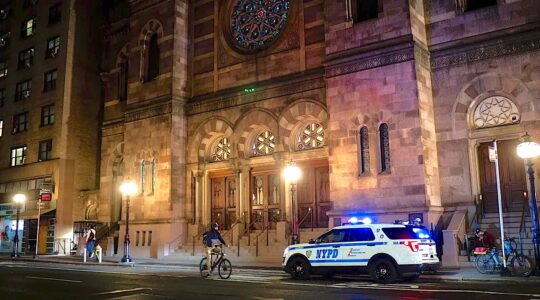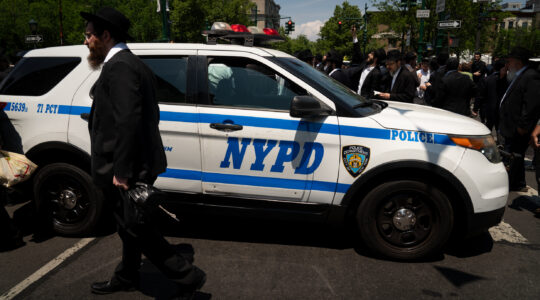Wherever you stop along the way, to traverse U.S. Route 66 is to retrace the mythic American westward journey — the same journey undertaken, often with unimaginable hardship, by generations of pioneers, Jewish and otherwise.
In the western United States, Route 66 overlaps with Interstate Highway 40 — the southerly east-west route from Wilmington, N.C. to Barstow, Calif. From time to time, I like to highlight some of the more intriguing stops found along cross-country highways, and I can think of no better pit stop midway through Arizona than the frontier city of Flagstaff.
Flagstaff is one of the more historic towns in a region (the Southwest) with plenty of history, true, but also one of its towns with more than its share of contemporary sprawl. A city of about 70,000 in a metro area twice that size, Flagstaff is the gateway to the Grand Canyon and several other regional attractions. So it hardly suffers for tourists.
But Flagstaff is more than a convenient jumping-off point for canyon-goers. Compact and quaint but far from precious, Flagstaff merits a day or two in order to savor its fragrant pines, its surprising morning coolness, the drama of its mountain backdrop. Flagstaff became a late-19th-century boomtown thanks to the same railroad that still brings trains through several times a day.
Many come to Flagstaff for its outdoor recreation, which makes sense: the city seems slight in contrast to the majestic wilderness that surrounds it. But as I observed on a trip with my mother, there’s plenty in this Gold Rush-era downtown for shoppers, too. It’s easy to while away a day puttering for Western tchotchkes in between excursions to the “official” attractions.
My mother was obsessed with Zuni jewelry — silver pieces inlaid with geometric designs in turquoise, carnelian and onyx — and she found plenty to satisfy her fix here. There are shops full of Hopi kachina dolls, colorful and befeathered, and places to buy frontier gear: boots, hats, belts. A few galleries, coffee shops and bookstores round out the offerings.
The eclectic, category-resistant Jewish community traces its roots to early Flagstaff pioneers, who established this Westward outpost in the late 1800s. Today, the Reform congregation Heichal Baoranim serves a broad swath of Northern Arizona Jewry. Out here in the West, I wasn’t surprised to hear that the rabbi specializes in Jewish meditation, or that members occasionally gather to pray at the rim of the Grand Canyon rim.
For most visitors, however, the Grand Canyon is just one of the area’s many natural lures. Just off the Interstate is Meteor Crater, where you can gawk at the truly stupendous hole where a giant ball of metal smashed into Earth thousands of years ago.
There is also Montezuma’s Well, which seemed to us neither much of a well nor much to do with Montezuma. It is a large, placid lake tucked into a hollowed-out rock formation near the site of pre-European cliff dwellings — which is to say that it’s a scenic spot for a picnic and a hike amid the fresh mountain air.
Closer into town is the Lowell Observatory, a venerable 19th-century institution for learning about the night sky. And what a sky it is. Amid these vast Western expanses, endless miles of red-rock plateaus and tumbleweeds, the sky is huge and seems to go on forever in whatever direction you look. At night, the heavens are inky-black, and there are more stars than you ever thought possible on the East Coast.
All of which makes the Lowell ideal for evening stargazing. Though the famous 19th century, 24-inch Clark telescope is out of rotation until sometime in 2015, a respectable stand-in is available for perusing the constellations, along with several other lenses (including a solar telescope for daytime sun gazing). Until recently, the Lowell’s chief claim to fame was as the site where Pluto was purportedly discovered as a planet; Pluto, you may have heard, has been demoted, but if they find a replacement, it may well be spotted here first.
Wherever you go in and around Flagstaff, the dark, sloping outline of Mt. Humphreys and the San Francisco Peaks dominate the horizon. Humphreys is so high — more than 12,000 feet — and the surrounding landscape so flat that you can see the peak looming from hundreds of miles around.
Support the New York Jewish Week
Our nonprofit newsroom depends on readers like you. Make a donation now to support independent Jewish journalism in New York.
I saw it as I drove toward Flagstaff and thought, hmm, nice mountain. A day later, I was still driving and the mountain was still in front of me. And it looked no bigger. When I finally got up close, its altitude was truly astonishing.
And that is Flagstaff in a nutshell. From far off, it doesn’t look like much. But the more time you spend here, as I discovered, the more there is to fascinate.
The New York Jewish Week brings you the stories behind the headlines, keeping you connected to Jewish life in New York. Help sustain the reporting you trust by donating today.




